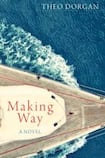
Tom Harrington, 50-something and recently bereaved, is sailing on the Mediterranean. His boat is The Lon Dubh, a "Cheoy Lee, built in Hong Kong 1960. Thirty-six footer. Teak all the way, solid. Bronze fastenings, Oregon pine mast and boom." The novel opens as Tom has a one-night stand with Christine in the harbour at Syracusa, on Sicily. The following day he meets up with another young woman, Clare Hogan, who goes aboard The Lon Dubh and stays. The owl and the pussycat go to sea.
Although John Gardner, the novelist and creative-writing teacher, famously said that there were only two kinds of story – a stranger comes to town, or somebody goes on a journey – not all that many novels are actually set on a vessel in transit. Even in the classic journey story, Robinson Crusoe, the real action happens after the hero leaves the ship. Of course, there are exceptions to this rule: most of Conrad's novels; Moby Dick; the great romantic scenes on the transatlantic liner in Brideshead Revisited; The Life of Pi. Nevertheless the story starts, as a rule,when you get off your bike, or your plane, or your boat.
Theo Dorgan, the well-known poet and passionate sailor, takes a brave step in selecting a sailing boat, peopled minimally with only two characters who seldom go ashore, as the location for this, his first voyage into fiction. The publicity material which came with my copy of the book cites prominently an Irish Examiner claim that "Theo Dorgan has . . . the sureness of the divinely inspired . . . which causes great resentment in the minds of lesser talents." Divinely inspired or not, can the author rise to the considerable challenge the very premise of this novel presents?
What can actually happen to two people on a boat? They can fall out with each other. Or out of the boat. They can fall in love. They can encounter pirates or storms or submarines or monsters. In The Life of Pi, there is always the interesting possibility that the boy on the boat will be eaten by his mate, a Bengal tiger. Neither Tom nor Clare are likely to do anything so dramatic. They are both well-balanced, chatty, sure of themselves, and likeable. He's an experienced sailor on a trustworthy boat. So, they could fall in love, they could have sex? But beautiful Clare, a bony long-limbed "ingenue", who occasionally prances about the boat in her knickers, rules this out, with some firmness, on page 11. Nevertheless the question mark hangs over the developing friendship – will they, won't they? – and generates some necessary tension. Tom doesn't give up on the possibility.
Clare and Tom pass the time by telling one another stories about their lives. Some, such as Tom’s account of the death of his beloved partner, Ruth, and hers about domestic violence, are gripping and moving. Yarns, such as one long story about a bodhrán-maker who uses dog skin rather than the traditional goat for his instruments, are diverting but seem irrelevant. There are a lot of breakfasts and dinners, and of the sort of innocent banter that keeps many a relationship afloat but can make an outsider wince. (“Gozo, Cap’n, sir!” “Very good, Miss Hogan, very good. The men not giving any trouble?” “No, Sir, Cap’n, sir!”) The sea is beautiful, the sea is mysterious, the sea is a metaphor for all kinds of ideas and feelings. But the sea can get a bit boring after a few hundred pages. (Which is why novelists like storms and icebergs.)
We do get there in the end. And the crisis, in the form of revelations by both characters, is worth waiting for. Tom’s secret is surprising, low key, and convincing, Clare’s more dramatic and contrived. Like all good revelations, they have been foreshadowed from the start, but subtly, so you miss the clues at the time but recognise them in hindsight. This is controlled storytelling – writing a novel is like sailing a boat, requiring a mixture of craft and intuition, and on the evidence of his handling of the climax, Theo Dorgan has both.
The writing is lyrical. Physical aspects of the voyage are described in rich detail. The language of sailing – jennies and mainsails and winches and staysails, lee cloth and port cloth and gusting 25 – is perhaps overused, although understandably so. But excess of love for words is not the worst fault a writer can have, and delight in language is a hallmark of this novel. There is no pared-back masculinist prose here, but unabashedly flamboyant sentences. Dorgan is not afraid of adverbs and adjectives. The flowing style of the opening chapters replicates the rhythm of waves: “The evening plumped itself over Ortiga, a soft dusk settling on the bay outside, a more velvety dark coming to roost in the spaces between the tall trees, between the trees and the high stone wall behind them.”
The novel deals with big questions, about love, death and the point of living. It is also to a great extent a man's exploration of women. "Tom liked women, women like Tom." The story closes at Deya, on Majorca, death place of Robert Graves. Ruth and Clare may in some way suggest white goddess figures, some sort of female force? Nevertheless, Tom is a more interesting character than Clare. It's Tom's novel – in the end, a story of the old man and the sea, not the owl and the pussycat.
Éilís Ní Dhuibhne's latest book is The Shelter of Neighbours. She teaches creative writing at the school of English, drama and film in University College Dublin.













